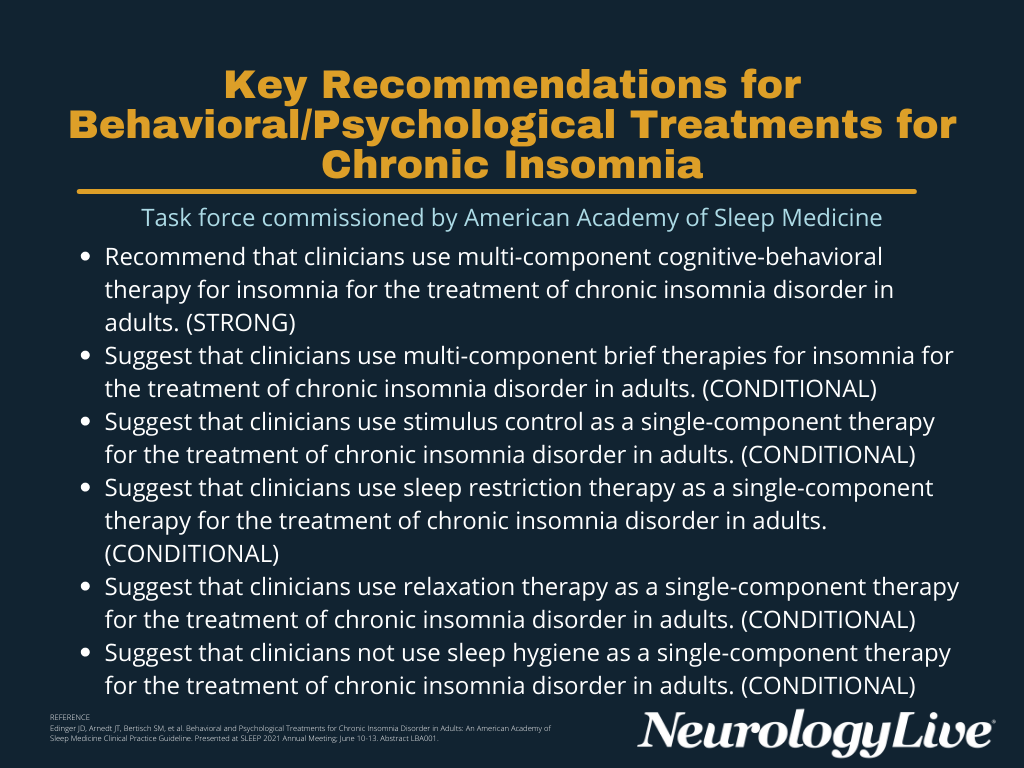Article
CBT-I Headlines AASM Guidelines for Chronic Insomnia
Author(s):
The task force assessed 6 total interventions, all of which received conditional recommendations aside from cognitive behavioral therapy for insomnia, which was strongly recommended.
Uzma Kazmi, MPH

The American Academy of Sleep Medicine (AASM) presented the recommendations that its task force of experts in sleep medicine have developed regarding the clinical practice use of behavioral and psychological treatments for chronic insomnia disorder in adults.1
The group assessed 6 total interventions—cognitive behavioral therapy for insomnia (CBT-I), brief therapies for insomnia, stimulus control, sleep restriction therapy, relaxation therapy, and sleepy hygiene. Ultimately, the task force offered up a recommendation for each of the 6, of which 1 was strong and 5 were conditional (FIGURE).
Uzma Kazmi, MPH, Clinical Guidelines and Research Manager, AASM, presented the guideline recommendations in a late-breaking poster at the 2021 SLEEP Virtual Annual Meeting, June 10-13.
“The recommendations take into consideration the quality of evidence, the balance of benefits and harms, patient values and preferences, and resource use considerations,” Kazmi said in her presentation. “A strong recommendation should be followed under most circumstances; the decision to follow a conditional recommendation requires the use of clinical knowledge and experience and a strong consideration of the patient’s values and preferences to determine the best course of action.”
FIGURE. Key Recommendations for Behavioral/Psychological Treatments for Chronic Insomnia

The task force developed its recommendations and assigned strengths by conducting a systematic review of the existing literature on the interventions and an assessment of the evidence using Grading of Recommendations Assessment, Development and Evaluation (GRADE) methodology. The AASM Board of Directors approved the final recommendations.
The presentation noted that the treatment of chronic insomnia disorder should be based on a diagnosis established using The International Classification of Sleep Disorders–Third Edition (ICSD-3) or Diagnostic and Statistical Manual of Mental Disorders (DSM–5) criteria, and a comprehensive clinical history. Current standard of care, according to the task force, should be to offer one of the interventions this new guideline recommends, with choice of intervention taking into consideration the same factors that the task force acknowledged in its process.
READ MORE: Pitolisant Further Demonstrates Clinical Benefit on Excessive Daytime Sleepiness, Cataplexy
The group did not make recommendations for single-component cognitive therapy, biofeedback, paradoxical intention, intensive sleep retraining, or mindfulness therapies (as a single- or multi-component intervention), mainly due to a lack of relatively extensive literature—fewer than 3 studies were available for each of those interventions.
Additionally, sleep hygiene, though recommended on a conditional basis, was not recommended to be used alone. “Although sleep hygiene is not recommended as a single-component approach for patients with chronic insomnia disorder, sleep hygiene can be included in multi-component interventions,” Kazmi said.
The task force noted that insufficient evidence exists to make any recommendations for specific delivery methods such as individual, group, internet, self-help, or video delivery, for any of the treatments assessed. As well, for all of the interventions aside from CBT-I, there was insufficient data to evaluate efficacy within patient subgroups.
“Some of the challenges patients face when undergoing any of these psychological treatments include the ability to attend sessions and adhere to treatment recommendations. In most cases, a noticeable improvement in insomnia symptoms is not immediate (as is the case with pharmacological interventions), and CBT-I treatment typically ranges from 4–8 visits, both of which may serve as barriers to treatment completion,” the group wrote in the guidelines.2 They added that the recognition of these challenges and relaying of realistic expectations is vital to utilizing these approaches.
For more coverage of SLEEP 2021, click here.





